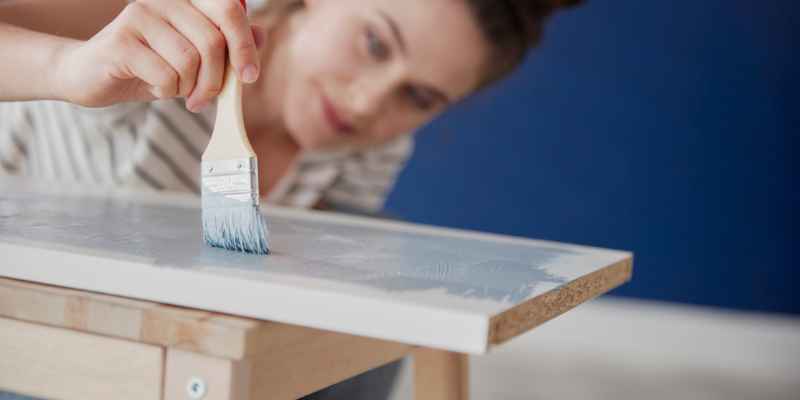Yes, you can paint furniture with wall paint. However, it is important to consider the type of furniture and the finish you want to achieve before proceeding.
Painting furniture is a popular way to update its look and breathe new life into old pieces. While there are specific paints designed for furniture, you may wonder if you can use regular wall paint for this task. The answer is yes, you can paint furniture with wall paint.
However, it’s crucial to carefully consider a few factors before diving into this project. This article will explore the compatibility of wall paint for furniture, discuss the importance of proper preparation, and provide some tips for achieving a successful finish. Whether you’re looking to transform a worn-out dresser or update your dining table, understanding the possibilities and limitations of using wall paint on furniture can help you achieve the desired result. So, let’s dive in and explore this DIY furniture painting option.
Why Paint Furniture?
Painting furniture can be a great way to refresh its look and customize it to your taste. While wall paint can technically be used, it’s not the best option as it may not adhere well and can easily chip or peel.
Using furniture-specific paint will ensure a durable and professional-looking finish.
There are many reasons why you might consider painting your furniture. From updating the look to expressing your personal style, painting furniture can revitalize your space and give you the opportunity to create something unique. In this blog post, we will explore the benefits of painting furniture with wall paint and the different ways it can enhance your home decor.
Update The Look
One of the main reasons people choose to paint their furniture is to update and freshen its appearance. Over time, furniture can become worn, outdated, or simply no longer fit with your existing decor. By applying a fresh coat of paint, you can transform a tired piece into something new and exciting.
Whether you want to give your furniture a modern, bold look or a more subtle, classic style, painting allows you to customize it to your taste. With a wide range of wall paint colors available, you can easily find the perfect shade to complement your existing color scheme or create a striking contrast.
By updating the look of your furniture, you can instantly breathe new life into your space without having to invest in all new pieces. This not only saves you money but also gives you the opportunity to get creative and showcase your personal style.
Express Your Style
Another compelling reason to paint your furniture is that it provides a platform for self-expression and creativity. Your furniture can be a reflection of your personality and taste, and by painting it, you can truly make it your own.
Whether you prefer bright and vibrant colors or more subdued tones, painting allows you to express your unique style and create a look that is entirely yours. Want to add some whimsy to a child’s bedroom or create a sophisticated feel in your living room? Painting your furniture is a simple and effective way to achieve these goals.
Additionally, painting furniture offers the opportunity to experiment with different techniques and finishes. From distressed and aged looks to sleek and glossy surfaces, the choices are endless. With a bit of creativity and the right techniques, you can transform your furniture into a one-of-a-kind statement piece that adds personality and charm to any space.
In conclusion, painting furniture with wall paint is a fantastic way to update its look and express your personal style. Whether you want to revitalize an old piece or add a pop of color to your decor, painting furniture provides endless possibilities for customization and creativity. So grab a paintbrush and let your imagination run wild!

Choosing The Right Paint
Painting furniture with wall paint can be a convenient option, but it’s important to consider its compatibility with different types of surfaces and the durability it offers.
Consider The Surface Material
Before painting furniture with wall paint, it’s crucial to carefully consider the surface material. Each type of material requires specific preparations and paint choices to ensure a successful outcome.
If you’re working with wooden furniture, sanding the surface is a must. This process smooths out any rough edges and removes existing layers of paint or varnish. Start with medium-grit sandpaper and gradually switch to finer grits to achieve a smooth finish.
On the other hand, metal furniture requires a different approach. Begin by cleaning the surface thoroughly to remove any dirt, rust, or grease. Lightly sanding the metal can help the paint adhere better. Applying a primer specifically designed for metal is also essential for long-lasting results.
When working with plastic furniture, it’s crucial to choose a paint that is formulated to adhere to plastic surfaces. Look for paints labeled as “plastic” or “multi-surface” to ensure the best adhesion and durability.
Selecting The Proper Finish
The finish you choose for your painted furniture can significantly impact its appearance and durability. Each type of finish has its own unique benefits and drawbacks, so it’s important to select one that suits your specific needs.
If you’re aiming for a sleek, modern look, a high-gloss finish may be the way to go. High-gloss paints reflect light, creating a shiny and polished appearance. They are also easy to clean and maintain, making them ideal for furniture that experiences heavy use or is exposed to stains and spills.
For those looking for a more understated and traditional finish, satin or eggshell finishes are excellent options. These paint finishes provide a subtle sheen that adds depth to the furniture without being too shiny. They are also more forgiving when it comes to concealing imperfections on the surface.
If durability is your top priority, consider using a matte or flat finish. These finishes are exceptionally resistant to scratches and scuffs, making them perfect for furniture that faces high traffic or regular wear and tear. Keep in mind that matte finishes can be harder to clean since they don’t have the same level of sheen.
Remember, when it comes to selecting the proper finish, consider not only the desired aesthetic but also the functional requirements of your furniture. With the right choice of paint and finish, you can transform your furniture into a statement piece that suits your style and stands the test of time.
Preparing The Furniture
When updating furniture, it’s best to avoid using wall paint. Opt for furniture paint specifically designed for a durable and long-lasting finish.
Cleaning And Sanding
Before you start painting your furniture with wall paint, it’s crucial to properly clean and sand the surface. Cleaning provides a clean canvas for the paint to adhere to, while sanding creates a smooth and even surface for a professional finish.
To clean the furniture, begin by removing any hardware or accessories that can be detached. Wipe down the surface with a damp cloth to remove dust, dirt, and grime. Make sure to get into crevices and hard-to-reach areas.
Once the furniture is clean, it’s time to sand it. Use medium-grit sandpaper to gently sand the entire surface. The goal is to create a slightly rough texture to help the paint adhere better. Sanding also helps to remove any existing coatings or imperfections.
Pro tip: Use a sanding block for more control and an even finish. Sand in the direction of the grain for smooth results.
Repairing Damages
Before applying wall paint, it’s important to repair any damages on the furniture. This step ensures that your final result looks professional and polished. Take the time to inspect the furniture for any cracks, dings, or chips that need fixing.
Use a good-quality wood filler to fill in any visible imperfections. Apply the filler with a putty knife, smoothing it out to match the surrounding surface. Allow it to dry completely before proceeding.
Once the filler is dry, lightly sand the repaired areas to blend them seamlessly with the rest of the furniture. This step ensures that the repaired spots won’t be noticeable once the paint is applied.
Pro tip:
For larger or deeper damages, consider using wood glue or epoxy to secure loose joints or fix structural issues.
Remember, proper preparation is key to achieving excellent results when painting furniture with wall paint. Cleaning the surface and repairing any damages sets the stage for a successful and professional-looking paint job. So invest the time and effort in preparing your furniture before you embark on this creative project.
Applying Wall Paint To Furniture
Applying wall paint to furniture is a creative way to give your pieces a fresh, new look. While wall paint can be used, it’s essential to consider the specific requirements of furniture surfaces for optimal results. Ensure proper preparation and choose the right paint type to achieve a durable and professional finish.
Painting furniture with wall paint is a cost-effective and creative way to give your pieces a fresh new look. Not only can you save money by using leftover wall paint instead of purchasing expensive furniture paint, but you also have a wide variety of colors to choose from. However, before you start slapping wall paint onto your furniture, it’s important to understand the proper techniques to ensure a professional-looking finish.
Using Proper Techniques
When applying wall paint to furniture, it’s crucial to follow the right techniques to achieve the desired results. Here are some tips to help you get started:
- Prepare the surface: Before applying wall paint to furniture, make sure to clean and sand the surface to remove any dirt, grease, or imperfections. This will create a smooth and even base for the paint to adhere to.
- Apply a primer: To enhance the adhesion of wall paint to the furniture, consider applying a primer first. This will also help to prevent the original color from bleeding through.
- Use thin layers: Instead of applying thick coats of wall paint, it’s best to apply thin layers. This will not only allow for better control but also ensure a smoother finish. Remember to let each layer dry completely before applying the next one.
- Use a brush or roller: Depending on the furniture’s size and surface texture, you can choose to use a brush or a roller. Brushes are ideal for intricate details and edges, while rollers are better suited for larger, flat surfaces.
- Consider sanding between coats: To achieve an extra smooth finish, lightly sand the furniture’s surface between coats of wall paint. This will help to eliminate any brushstrokes or unevenness.
- Finish with a sealant: Once you have completed painting the furniture, consider applying a sealant or clear coat to protect the paint and increase its durability. This will also give the finished piece a glossy or matte appearance, depending on your preference.
Tips For A Smooth Finish
To ensure a smooth and professional-looking finish, here are some additional tips to keep in mind:
- Choose the right paint: Opt for a high-quality wall paint that is suitable for furniture use. Look for paints that offer good coverage and durability.
- Practice on a small area first: If you are unsure about the results, it’s always a good idea to test the wall paint on a small, inconspicuous area of the furniture before proceeding with the entire piece.
- Work in a well-ventilated area: Ensure that the area where you are painting the furniture is well-ventilated to prevent the build-up of fumes. Open windows or use fans to keep the air flowing.
- Take your time: Painting furniture with wall paint requires patience and attention to detail. Take your time to apply the paint evenly and allow each coat to dry fully before proceeding.
- Clean and store your brushes properly: After each use, clean your brushes thoroughly with warm, soapy water. Store them in a cool, dry place to prevent them from drying out or becoming damaged.

Finishing Touches
Painting furniture with wall paint is a common practice for DIY enthusiasts. However, it’s important to consider the durability and finish of wall paint, which may not be suitable for furniture. Explore alternatives like specialty furniture paint for a professional and long-lasting result.
Applying A Protective Topcoat
After you have successfully transformed your furniture with wall paint, it’s important to add a protective topcoat to ensure its longevity. A protective topcoat not only adds a layer of durability but also helps to seal in the color and finish of the painted furniture. There are a few different options when it comes to selecting a topcoat for your painted furniture:
- Polyurethane: This is a popular choice for protecting painted furniture. It provides a clear, glossy finish and is available in both water-based and oil-based formulas. Water-based polyurethane is easy to clean up and dries quickly.
- Wax: Wax is another option for adding a protective finish to your painted furniture. It helps to enhance the color and gives a soft, matte finish. However, keep in mind that wax may require more regular maintenance and reapplication compared to other topcoat options.
- Polycrylic: Polycrylic is a water-based protective finish that dries quickly and provides a clear, durable coating on painted furniture. It is less likely to yellow over time compared to oil-based options, making it a great choice for lighter-colored furniture.
When applying a protective topcoat, it’s essential to follow the manufacturer’s instructions and use the recommended tools, such as a brush or foam applicator. Apply the topcoat in thin, even layers, allowing each coat to dry completely before adding another. This will help to achieve a smooth, professional-looking finish.
Adding New Hardware
Upgrading the hardware on your painted furniture is a simple and effective way to give it a fresh, polished look. Whether you are painting an old dresser or a wooden cabinet, replacing the hardware can make a significant difference in the overall appearance.
When choosing new hardware, consider the style and color of your painted furniture. Sleek, modern hardware can give a contemporary feel, while vintage-inspired knobs or pulls can add a charming, nostalgic touch. Ensure the size of the new hardware matches the existing holes or make necessary adjustments.
To install new hardware, simply remove the old pieces using a screwdriver, then attach the new hardware in the desired location using the provided screws. Take your time to align it properly and make any necessary adjustments until you are satisfied with the placement.
Remember, the finishing touches are what truly elevate the look of your painted furniture. By applying a protective topcoat and adding new hardware, you can enhance the durability and appearance of your furniture, creating a stunning piece that will stand the test of time.
Conclusion
Painting furniture with wall paint can be a feasible option, but it requires careful consideration. While it may provide a cost-effective solution, it may not offer the same durability and finish as furniture paint. It’s vital to properly prepare the surface and use appropriate techniques for the best results.
Ultimately, the choice depends on your preference and the desired outcome you wish to achieve.


